UX Research, the complete guide to reach ferpection
UX Research is an exciting and fast-moving heuristic approach based on user needs and behavior. It combines methodologies, tools and the goal of putting user experience at strategic level for organizations of all sizes. In this UX research guide, we will look together at topics such as:
- UX research, why and how to implement it?
- The value of UX Research.
- How do these methods relate to UX Design?
- Concrete examples of market studies, testing and research.
- How does one become a UX Researcher?
- And much more...
So, if you want to make user experience an asset for your projects, your business or your career, follow the guide.
Contents
- Definitions: UX Research, user research, UX research
- Why do UX research?
- The different UX research methods
- How to succeed in your UX research? How to implement UX research?
- The job of UX researcher
- How can you make UX research work for you?
Definitions: UX Research, user research, UX Design
In this chapter, we will answer some fundamental questions. What is UX Research, what are its origins and how does it differ from its cousins such as UX Design or user testing?
For the record, UX or User eXperience, groups together approaches that aim to capture the user's point of view about a product or service, as opposed to the sole point of view of the designer of this experience. They will thus enable us to understand - UX research - or influence - UX design - user behavior.
What is UX research?
UX Research aims to understand the expectations, reluctance and behavior of a target population towards a product or service over time. This may be existing or future, in concept or prototype form. The aim will be to improve its adoption and by extension its value to the organization offering it. For example, you may wish to improve the conversion rate of an e-commerce site.
It relies on qualitative and quantitative research methodologies. Historically linked to software and then to the Internet, UX Research can nevertheless be applied more broadly to any user experience, for example in a store. In this respect, it is similar to heuristics, the art of discovery or, more prosaically, the method of solving problems on the basis of incomplete knowledge.
Origins: Don Norman, Nielsen's 5 users and the term User Experience...
Symbolically, UX Research and UX Design were born in 1993. While behaviors similar to listening to users may have existed from time immemorial, the need to make this a more systematic approach has emerged more recently:
- Increasingly technical products are being put on the mass market whereas previously they were reserved for trained people.
- These products are increasingly controlled via an interface, or even merged with software and now even a website or mobile application.
One personality, Don Norman, embodies the emergence of UX Design and UX Research:
- In 1988, he published the book "The Psychology of everyday things" which was later renamed "The Design of everyday things"
- In 1993, he took the position of User Experience Architect at Apple, the first job officially dedicated to user experience!
- In 1998, he and Jakob Nielsen founded the Nielsen Norman Group, part agency, part institute, 100% UX!
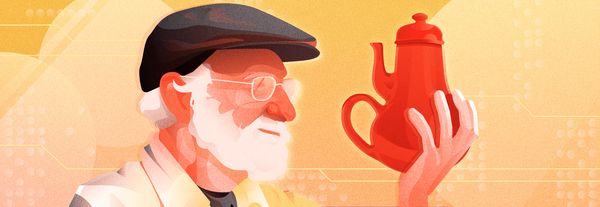
Credit: Andy Ng, 2020
Also in 1993, Jakob Nielsen , together with Thomas K. Landauer, promoted a more scientific approach to user behavior with an academic publication in April 1993. One of the things that history has learnt from their research is that it only takes five users to discover 80% of a website's problems. It is actually more subtle than that, and we have a copy if you're interested in learning more!
Synonyms for UX research
In English, we talk about user research, UX research or even user experience research. The French translation was initially literal with "recherche utilisateur" (user research) and "recherche UX" (UX research), but French also came to use "étude UX" (UX study), "recherche utilisateur UX" (UX user research - which may well be a tautology?), and eventually "stratégie UX" (UX strategy).
With these various terms, you can take your pick, even though the safest bet would be to use the term "UX Research" as a priority, as it is a direct correlate to its alter ego, UX Design. And finally, UX is an abbreviation of User Experience, or "expérience utilisateur" in French. These 3 terms are also interchangeable.
What is the difference between UX research and UX design?
UX Research and UX Design are closely linked. In two words: understanding vs. creating. While UX design seeks to influence behavior, UX research provides the levers for that influence.
In essence, UX Design draws on the user's point of view, as it aims for a design that is as easy to use as possible. UX research asks the questions that will provide the keys to user needs and behavior. While it is possible on a small scale for the same person to carry both responsibilities, this quickly becomes counterproductive:
- Firstly, because the creator becomes a judge and may be biased if they are also the one who evaluates the creation.
- Secondly, because both interface design and research activities are very time-consuming, which makes it difficult to balance the two.
- Finally, because, despite a common grounding in psychology, the skills required for each are rich, varied and demanding. Just within UX Research, there may be, for example, UX consultants with social science skills and others with a better command of the more statistical aspects.
Peter Merholz, renowned designer and author of books on UX design, shows that there are too many skills expected of a designer today for one person to master them all:

What is the difference between UX research and user testing?
User testing is one of the historical components of UX Research and one of its main contributions. Supporting the design of a new interface with one or more phases of user testing is at the heart of UX Design. However, UX Research now goes much further:
- It is possible to combine the tests with the exploratory part of the market studies, for example to precede them by a customer knowledge phase.
- To produce insights (user truths) from various qualitative and quantitative research methodologies, but also from data typically coming from tools and methods such as: Google Analytics, heatmaps, AB tests, etc.
- To reconcile the lessons learned over time from various studies, regardless of the UX method used, for example via atomic research.
Market research vs. user research
Market research, testing, measurement: from a distance, UX Research seems very similar to market research. In practice, however, traditional research institutes are rarely found on these projects. So what makes them different?
- The systematic approach over time.
- The connection with design in a spirit of continuous improvement.
- Specific innovations such as remote user testing.
- The need for agility.
- And often the web and mobile expertise of UX projects, such as when it comes to optimizing conversion rates in practice.
The link between UX research and design thinking
'Design thinking' is a UX design approach that focuses on both innovation and user needs. UX methods will therefore often be used. However, design thinking is often associated with a project with a defined beginning and an end, where the value of UX research grows with time and the number of projects covered. In summary, design thinking will borrow aspects of testing and research for a specific need, whereas UX Research will systematize these methods at the enterprise level.
The following example shows a study process built on the double diamond logic, often found in design thinking. We see an alternation of divergence and convergence phases to which we have associated in this example different methodologies: user interviews, focus groups, online survey and remote user testing.
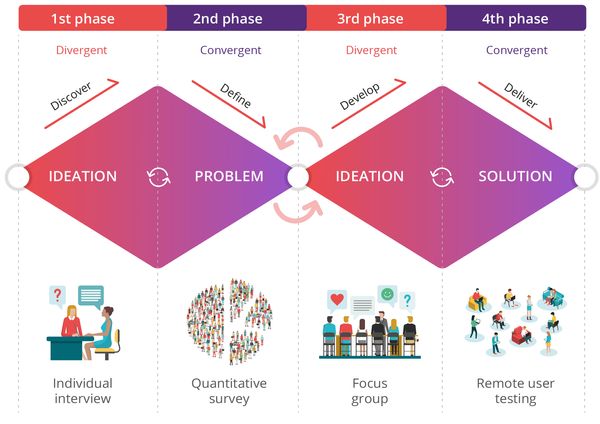
UX research: asking questions to better understand it
UX research asks questions to understand and act in response to the expectations expressed or not by users. This will allow us to build or improve an offering: product, website, mobile application, service design. Through precise research, testing and analytics methodologies, it provides the insights - or customer truths - that will influence the design of this offer, from ideation to UX design and finally to UI design.
In this section, we will look at some examples of research objectives and then focus on what makes UX research a discipline: its strategic, omnichannel aims, beyond individual projects and countries. Our UX research video, beyond user testing, details these different topics.
What is key in user research and what are the objectives?
Some examples of the goals of UX research are:
- Explore new strategic directions.
- Assess the potential of a new or existing market.
- Capture the expectations of a target population.
- Understand user needs.
- Improve the current or future user experience.
- Boost conversion rates.
- Reassure yourself and others about the chances of a successful market launch.
- And many others...
The usefulness of this approach
The fields of application are very broad, although they can be grouped into two main categories: exploring possibilities and auditing an existing or planned execution. Beyond that, your imagination is the only limit to finding research topics that can change the future of your business. Don't forget that UX research has inherited both the advances of the last 20 years in UX analytics and, more importantly, over a century of social sciences - most notably psychology and sociology. The key is to ask the right questions.
For example, let's say you are working on a connected object to measure your sleep. Will you be satisfied with testing existing iOS / Android apps or will you go further to understand what science tells us about sleep and even dreams? In the first case, you'll do user testing and that's a solid start. In the second, you will do UX research with the aim of opening up new possibilities for your business.
Project vs. product or, continuous improvement
In the classic approach to IT projects, start and especially end dates are used to limit the scope of action. This could be the launch of a website or the roll-out of a new version of a mobile application. In the product approach, we will seek to improve continuously over time. There will be staging points but no finish line.
UX research serves both of these purposes but ideally promotes a continuous optimization process, asking questions and learning all the time. In addition, the UX approach seeks to capitalize on the knowledge gained from past projects and improvements to save time on new actions.
Operationally, UX methods are organized around a user roadmap equivalent to the product roadmap. Over time, atomic research aims to organize this systematic review of learnings by enabling traceability of learnings and their reconciliation between projects and over time.
Omnichannel, from shop to website and beyond
In the 90s when UX design emerged, this subject was strictly limited to HMIs or human-machine interfaces, especially on computer software. Even the Internet was in its infancy, not to mention mobile applications.
Nowadays, digital is everywhere and any user journey, whether in a shop or in contact with customer services, may be supported with a digital element on a smartphone, a computer, a connected terminal, etc.
The optimization of this user experience must therefore be understood in its entirety, both within the interfaces and outside them! From this point of view, the UX research approach is likely to influence not only UI design but also the design of services and all the components of the experience.
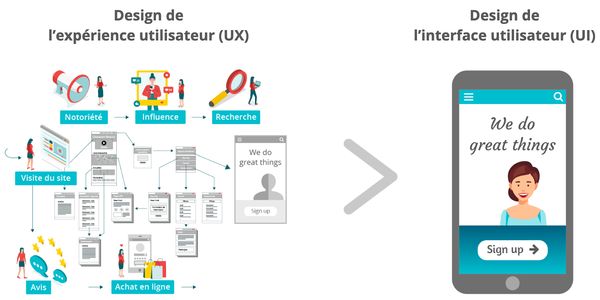
UX performance and how to measure the success and value of user experience
How can we assess the value of the user experience? What are the components? What is the R.O.I. or return on investment? This is a very wide subject. It ranges from the classic conversion rate measured via Google analytics to the societal impact of brand experiences. We shared with the UX community on this topic in a video webinar by detailing the 5 types of UX performance indicators:
- Satisfaction
- Business
- Productivity
- Brand image
- Societal
When UX becomes a strategic issue
Originally part of operational optimization, UX research is now tending to focus on more strategic insights:
- customer knowledge leads to the identification of new markets, new offerings, prioritization of areas for innovation...
- the holistic approach pushes organizations to work across functions and rethink their processes.
- the concept of UX performance, lastly, guides the actions of companies through user experience indicators.
Defining the UX maturity of an organization
Back in 2014, Juan Manuel Carraro proposed the Keikendo model to assess the UX maturity of each company. It has 5 stages of development:
- Unintentional, the user experience by accident
- Self-Referential, user experience as awareness
- Expert, user experience by experts
- Centralized, the industrialized user experience
- Distributed, user experience as a strategic business performance indicator.
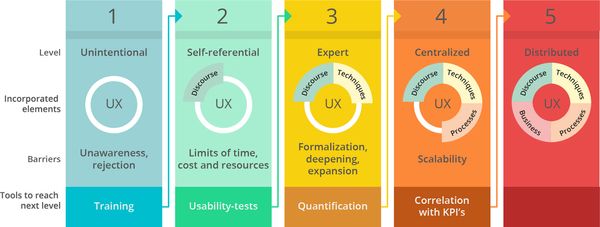
Developing internationally
A word to conclude this section on international UX Research as many brands will be considering their success at a global level. To do this, they will need to take into account country specificities. As part of their training, UX Researchers learn how to manage this diversity, although they will ideally call on local experts. The latter will be able to ask the right questions and identify their local cultural specificities. In this type of international study, the challenge is to distinguish between local specificities and the results of the study - regardless of the country. Here are some examples of verbatims where the original language was English, Portuguese, German, Chinese and Japanese:
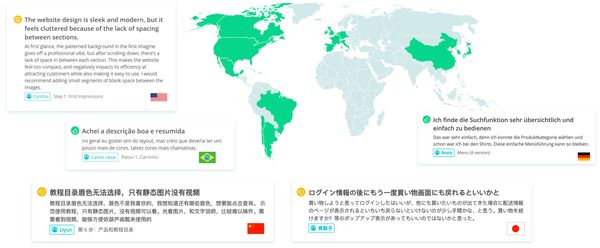
What are the UX research methods?
The methodologies associated with UX research are really very valuable! They enable analysis of user needs and behavior. In this part we have a good program:
- list the main quantitative approaches,
- do the same for qualitative methodologies,
- identify user testing techniques,
- to end with the complementarity between qualitative and quantitative methods,
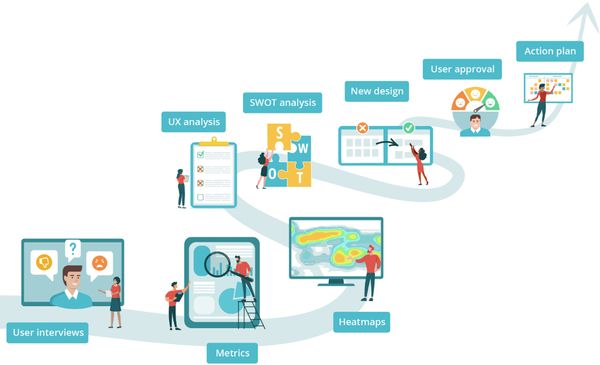
Quantitative methods and associated measurements
- The advantage of a survey is that it collects declarative data from a large number of individuals. How many individuals, do you think? More on this below. Historically, this was done both in writing and by telephone, although online surveys now make up the vast majority.
- Analytics tools provide you with statistics on the number of visitors to and use of your site. A distinction is made identifying site-centric tools such as Google analytics, which analyzes the data seen on the site. There are also user-centric tools such as Content Square, which analyzes data from the point of view of the visitor to a website or user of a mobile application.
- The AB test makes it possible to determine, on the basis of a performance indicator, the best of two solutions for a single parameter and an indicator, for example the conversion rate. There are also multi-variant models where several parameters are taken into account.
- The heatmap aggregates the hot and cold areas measured over a large number of user paths. Hot represents where the mouse moves or clicks the most, cold the opposite. It allows you to see just in a few moments what most attracts the attention of visitors.
- Eye tracking, initially a qualitative technique, has also developed via the use of webcams with technical limits linked to the equipment and legal limits concerning consent.
Qualitative methods
- The individual interview during which a qualitative interviewer will get the respondent to talk about their views on a subject. Depending on the level of depth sought, the interview can be directive, semi-directive or exploratory. It can be done face-to-face or remotely by video conference or by telephone. The strength of this approach is twofold. The interviewer may ask follow-up questions to probe certain topics. He or she can also interpret the unspoken part, for example via the interviewee's body language.
- The focus group has two main benefits that can be combined in one session. It allows generation of new ideas around a theme or concept and is based on creative techniques. It also permits study of the group's reaction to an offering, a product or a concept. Because of its collective nature, however, it is less relevant for testing individual experiences such as a website, software or mobile application.
- But also ethnographic studies, beta-testing communities, task analysis, card sorting, eye-tracking in a room...
For more detailed information on cognitive biases, interviewing and facilitation techniques, please see our detailed guide to qualitative research.
User testing methodologies
- Semi-structured interviews are particularly relevant to the individual experience of each user. They are what we call moderated by a qualitative specialist who leads the session and asks the questions.
- Guerrilla testing is a simplified version of interviewing. Conducted in an everyday setting such as a café with people recruited on the spot, it overcomes the cumbersome logistics associated with interviewing. The downside is less targeted recruitment and a more superficial interview.
- Self-administered remote user tests on tools offer rapid testing under real conditions. There is no moderator, one-way mirror or any other element influencing the user during monitoring of their behavior. They can be completely unmoderated or post-moderated to ensure the quality of the verbatims for example on the Ferpection platform.
- The "5 seconds test" seeks to determine what a person understands about a site on their first impression, while the "first click test" identifies the path chosen spontaneously - the first mouse click - to perform a given task. Both are suitable for visits where the user is not very involved.
Mixing qualitative and quantitative methodologies
Whether for UX research or market research, mixing qualitative and quantitative approaches is often a key success factor. In the case of UX research, these two approaches answer complementary questions:
- What and who? The quantitative study shows what is happening and to what extent.
- Why and how? The qualitative approach explains the decisions behind these actions.
The order in which you answer these two questions - and therefore the order of the methods - is important and should be determined on a case-by-case basis depending on your objectives.
Finally, be aware that there are possible exceptions, such as the possibility of constructing qualitative surveys if, for example, it proves complex to speak directly with the users you wish to interview.
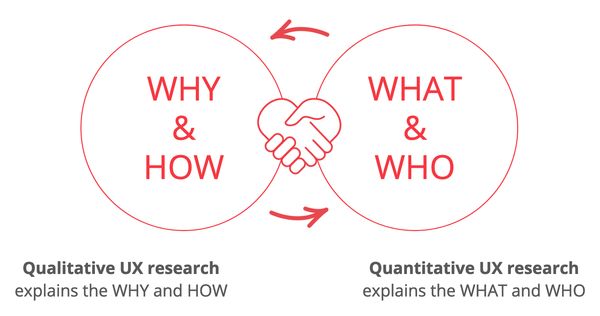
Set up and succeed in your UX research
Now that we have started to explore what it is possible to achieve through listening to users, let's see how to make it a success:
- At what point should user needs be included?
- How do you organize it?
- What sample size should you recruit?
- How do you successfully analyze a market research or user test?
- What type of service provider should be used to carry out these studies?
When should user experience be addressed?
Start early and regularly! Integrating client knowledge from the beginning of your project gives you the necessary leeway to make changes. Making UX design changes at the wireframe stage will cost you:
- three times less than during web, iOS or Android development
- ten times less than once your product is on the market.
Regularly checking in with users means inviting them to the table for your project and never losing sight of their point of view. This is also what fuels UX Design! The organization of the various UX studies can be done via a user roadmap, which is a real counterpart to the product roadmap.

How long does it take to set up a UX research study?
The time required to organize a study varies greatly: from a few hours for guerrilla testing to several months for a study involving several methodologies and countries. However, a study typically takes 3-6 weeks to complete:
- framing,
- recruitment,
- study area,
- analyze,
- UX recommendations
- and reporting the results.
UX design agency, SaaS testing tool, research institute, UX consultant... Who are you going to call?
There are a wide range of providers of user testing and research. As an agency specializing in UX Research, our view is necessarily biased, but here is a first overview:
- The research institute is the historical gold standard. It excels at building and implementing a tailor-made methodological system. Most institutes, however, have not made the shift to digital or have done so only to a limited extent. They are less sensitive to the UX design dimension, which is synonymous with agility and operational recommendations to improve the conversion rates of your customer or user paths.
- The UX design agency and by extension the web agencies or creative agencies are the counterpart of the research institute. They bring the design dimension to you and will instead partner with other players to conduct UX studies. So much the better, that prevents them from becoming judge and jury of your projects!
- The panellist is a specialised player who helps you in the constitution of your sample.
- SaaS testing tools: these products provide you with fast test results. On subjects as technical as studies, you should demand tailor-made support, both upstream to design the protocols and downstream for the analysis and UX design recommendations.
- Finally, the UX specialist consultant can be independent, part of a specialist UX Research provider such as Ferpection or an internal member of your team.
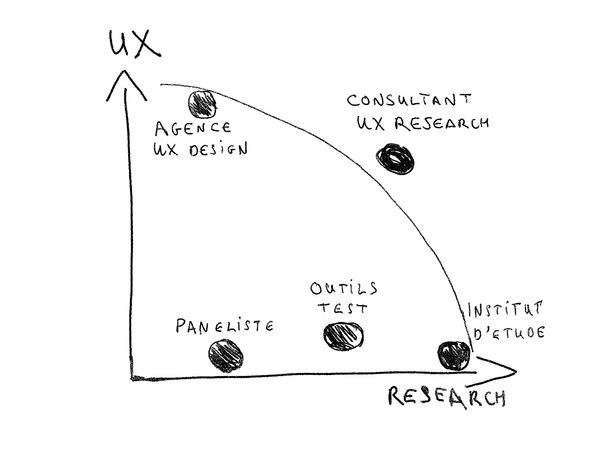
Build the sample according to your study and your UX strategy
The sample size depends primarily on whether you are using a qualitative or quantitative approach:
- For quantitative approaches, it is common to set up a panel of 300-500 people, even if, here again, certain study configurations - targets, need to cross-reference data - may require a lower or higher sample size.
- On the qualitative side, each series or session typically includes 5-15 individuals per target and per country, with variations depending on the methodology.
- A qualitative sample does not need to be representative, but appropriate targeting criteria are still necessary for good recruitment.
- Qualitative as quantitative, statistical data obeys mathematical laws that dictate what can be done in terms of analysis: use of the average, order of priority, margin of error, confidence in the sub-samples resulting from the crossing of targeting criteria, etc.
Analyze the results of a user study or test
- Review your initial hypotheses, those that led you to launch this UX research method.
- Include in the analysis the limitations of the chosen methodology such as cognitive biases.
- In an international study, take into account local cultural references.
- Consider all the results, whether they come from an adhoc study, your analytics, or a user test, for example.
- Now identify the strong trends more specifically and classify them by frequency and criticality.
- In the case of market research, perhaps you can refine the results based on a sub-target or persona?
- In the case of UX analytics, focus on what is happening factually without seeking to interpret. The friction points that you may discover will be the subject of hypotheses to be tested during a qualitative study phase.
- In the case of user testing, identify strengths to build on and weaknesses to improve.
- Compare the final results with your hypotheses: which ones can you confirm or refute?
- Prepare a summary of the results in the form of an action plan: what will you change in your business in future? Do you need new hypotheses to investigate?
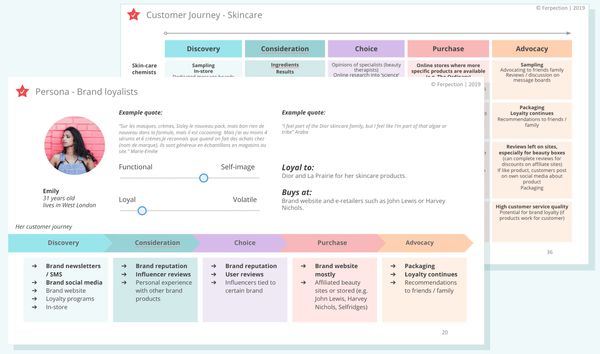
UX application example: client knowledge
Typically, when launching a new offering, knowing who will buy your product or service will lead to a series of key questions:
- What percentage of the population - or penetration - can you expect?
- How many segments of the population will be interested or resistant?
- What are the reasons for this? What are their socio-demographic characteristics, for example?
A mix of qualitative and quantitative research, for example individual interviews followed by an online survey, will allow these different segments to be identified and measured precisely. Personas or - to be more exact - archetypes can then be deduced, as in this example related to the job seeker market:
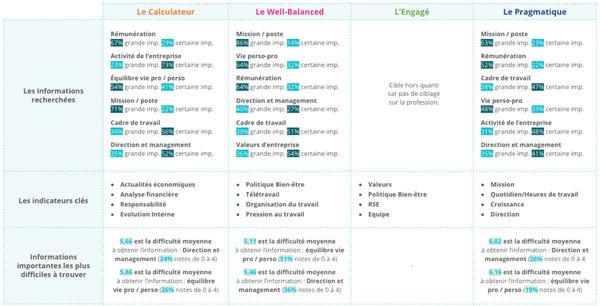
Perhaps most interestingly, we will be able to deduce from these archetypes what will or will not interest them in your product or service. Here is a second example of this insightful analysis in the mobility market:
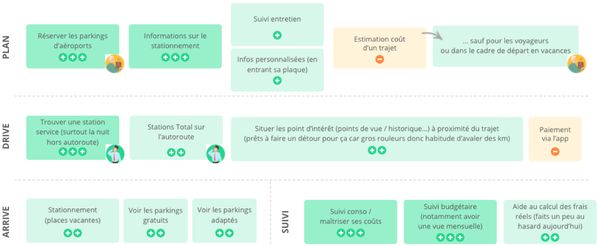
The job of UX researcher
Have you always dreamed of leading focus groups or analysing tests for the next hot website? Being a UX Researcher is an up and coming, varied and exciting profession that gives free rein to your listening and analytical skills. While the job is technical with advanced hard skills, it is more likely to be your soft skills that will make the difference with employers. In this section we will look at:
- the practical aspects of the job such as roles and salary,
- the current pathways to this profession,
- the difference between UX Researcher, UX Designer and UI Designer.
What is a UX researcher?
The UX researcher will attempt to hear - in the broadest sense - and understand the expectations and stumbling blocks of users, whether they are prospects, customers, employees, etc. This is why the UX consultant first develops soft skills, primarily listening and analysis. It's a job where you learn to ask questions including questioning yourself in all humility.
It also gives a long-term - and international - role to market research, user testing and behavioral analysis. This is why its projects have become more strategic since the insights discovered from project to project have the potential to feed into strategic opportunities for the company. You will therefore also have an evangelizing and influencing role to fully champion the voice of users.
Of course, it comes with technical skills but the catalogue of methodologies and tools available is constantly growing so there is no expectation of already having mastered everything. Rather, part of the expertise will be to know how to call on others to focus on how to approach research projects and their framing.
The key to UX research is twofold:
- learn to ask the right questions.
- take into account the biases inherent in the study techniques chosen.
This learning is done through experience, especially as the profession is still young and you will rarely have an expert manager to discuss it with. Don't forget to call on the UX community, which is very supportive!
How do you become a UX researcher?
Let's face it, there is no specific degree dedicated to UX Research today and there are people with a variety of backgrounds on the market. This is good because UX studies draw from multiple disciplines. These backgrounds can be in both initial training and professional retraining. There are three main archetypes:
- The UX designer, with a background in design or ergonomics, who wants to be more involved in the upstream creative work.
- People with a business school education. For those who like to be in contact with people, it is natural to retrain after some experience in a research institute, in marketing or in communication.
- Academic backgrounds in the humanities and social sciences, such as psychology. More than in the Anglo-Saxon world, those with academic profiles are more distant from private companies and can sometimes have difficulty adapting. The digital world and its agility can be a shock to those who have built careers around a more 'pure' approach from an academic point of view.
In any case, keep in mind that, like any digital topic, this environment is evolving extremely fast. Being proactively curious and enjoying change is a prerequisite for your career.
Which course should you choose?
You will find courses called UX research or user research in the UX Design courses at the Gobelins or Multimedia colleges, for example. Other more general training programs may also offer courses.
Then, an internship or a training contract will enable you to gain practical experience setting up user tests, focus groups, card sorting, Google analytics...
In preparation for a career change, you can experiment with simplified research methodologies in your current job. This is the merit of simple methods such as card sorting and above all guerrilla approaches - guerrilla testing, guerrilla UX, UX analytics. They allow you to carry out field studies, certainly on a smaller scale, but they are also less costly for your employer to deploy.
For contacts, you will find peer networks open to coaching on LinkedIn like UX design family, events organized by Flupa, in groups on Slack or podcasts full of feedback.
The UX Researcher job: salaries, job trends
UX research was born in the United States in the wake of UX design. And, just as we have caught up in Europe on UX design, the UX research side is growing fast but is very immature. Opportunities will increase in the coming years, but the same job title can cover very different realities.
Salaries are close to those of UX designers, with comfortable entry-level salaries. On the other hand, since the profession is new, solid backgrounds with more than 5-6 years of experience are rarer and it is quickly apparent there is a lack of data on the most senior levels. Here is a 2021 benchmark of salaries, in France, for the profession based on similar functions:

Sources: Iergo, Urban Linker, Michael Page, LinkedIn, Silkhom, Digirocks, WTTJ, Glassdoor, Hays...
This is an industry where there is parity between men and women, much more so than in design, which still tends to be fairly male-dominated.
UX researcher, UX designer or UI designer?
Do you like understanding? Focus more on UX research. Do you enjoy creating? UX UI design is for you. Then the choice between UX and UI is made at a more detailed level of your experience. Like for a fullstack developer, it is possible to combine these three professions within certain limits. However, at the beginning of a career, it helps to understand how they work together.
But for the sake of your projects, this quickly becomes counterproductive because of the same cognitive biases that you study as a researcher. We are all susceptible to confirmation bias, which unconsciously leads us to confirm what we believe rather than to understand neutrally.
It is therefore more than essential to separate creation from understanding. For a UI designer, this can be compounded by the frustration of leaving the design behind. UX research is more about observing than doing.
And afterwards, what is the career path for a UX Researcher?
- Become a freelance UX consultant: the job lends itself well to those who are looking for an independent project-based role.
- Climb the corporate ladder to international positions or more technical positions such as Product Owner.
- Open up to other disciplines in innovation or design thinking, for example.
Other careers will emerge but are still difficult to ascertain as the discipline is very new.
How can you make UX research work for you?
Now it's up to you. You have the first key facts on how make UX research an asset for your projects, your organization, your job. And if you need some guidance on how to do this, the entire Ferpection team behind this guide is here to help you with your UX audits, online user testing and focus groups to name just a few examples.